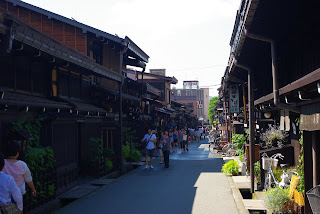I had a lot of things planned for today, so I tried to get an early start, checking out of the hotel and leaving my bags with reception for the day. I walked to Sannomiya station in central Kobe and took a train headed west along the coast of Osaka Bay.
My destination was a pair of structures by Japan's most famous architect, Tadao Ando, both built on Awaji Island.
As I approached Maiko station, out the window I could see the enormous span of the Akashi-Kaikyo Bridge, the largest suspension bridge in the world. Its length is more than 150% of the length of the Golden Gate Bridge in San Francisco. The station where you can pick up a bus that takes you across the bridge is actually on the bridge itself. From the train station at ground level, you take two elevators to the bridge level to reach the bus station.

The bus dropped me off at the Awaji Westin Hotel which also happens to be the location of Ando's Awaji Yumebutai. Built into the side of a mountain, this site was actually the location where all the dirt was excavated for an artificial island in Osaka Bay that Kansai International Airport was built upon. The idea was to rebuild the carved out mountain side into an environmental park, gardening laboratory, and performance space that blends into the surrounding landscape. Ando created an impressive structure with concrete framing gorgeous views and forums for performances, numerous waterfalls, flower displays, and greenhouses. It is a sprawling piece of architecture, with many places to explore.

The views across the bay were spectacular, with Kobe and Osaka easily visible in the distance at the base of steep mountain ranges. I spent at least 2 hours exploring the place and taking pictures.
I happened to run into an architect from Canada and two men from Thailand, both of whom were also there to see Ando's work. We all had Ando's Water Temple next on the agenda so we took the bus over together.
It was starting to become a very hot afternoon, and the
Water Temple is not exactly easily accessible. It was about a 15 minute walk up a steep, unshaded slope from the bus stop on the main road. By the time we got the top we were exhausted, and briefly pondered the idea of just jumping into the water instead of entering the temple.
A very deliberate and interesting path brings you inside the temple grounds. You ascend up a path through a hill of gravel and enter a perforation through a curved concrete wall, and then you follow another curved wall back the other way before you come around the edge to open up a view across the water filled temple covered with lily pads and lotuses.



A staircase takes you down beneath the water's surface into a dark chamber.

Surprisingly, inside the temple itself there were more traditional elements than I expected. The red vermilion wood, religious signs and figures, and the altar were used in similar ways to the many traditional temples I'd seen. However, here it is all integrated into a modern oval shaped chamber of concrete.
We headed back down to the bus stop before we looked at our bus schedule and realized that the next bus wouldn't arrive for another 90 minutes! We were frying out there on the sidewalk. We ended up walking for 20 minutes back to the hotel to see if we could catch another bus back across the bridge from there, but it turned out that it didn't make a difference. We were stuck there. At least at the hotel we could duck in for some air conditioning, though.
By the time I got back to Kobe, I'd lot a lot of time, unfortunately. I did manage to briefly stop at two more places I had wanted to visit, but sadly they had closed early that day for some reason. The Kobe Earthquake Museum was a pretty cool building on it's own. It's pretty bold to build an earthquake museum almost completely out of glass, but despite the materials, the building itself is supposed to be extremely resistant to the strongest earthquakes.
Next door was a contemporary art museum, again by Ando. The building form is quite dramatic, with huge horizontal overhangs cantilevered out over the stepped facade. I would have liked to have seen the inside, but it will have to wait until next time.
The boardwalk along the water in front of these two buildings was also a popular place for bikers.
I stopped back at my hotel to pick up my bags. Unfortunately for me, the wheel on my bag seemed to have finally given out, and I was forced to drag my bag almost the whole way to the train station. The heat and the exhaustion were killing me! Eventually I made it to the station, grabbed some food for the ride, and slid into my seat on the comfortable, air conditioned Shinkansen bound for Nagoya.
My hostel in Nagoya wasn't too far from the station, thankfully, and it was a pretty nice place, too. I got the bunk right under the air conditioner, which is actually just fine in the heat of the Japanese summer. I managed to pull myself together enough to do a short night out, hopping on a subway train bound for Sakae station in the center of town. Nagoya seemed like a pleasant place actually, with lots of parks and handsome architecture, at least from the parts that I saw. I ended up at an Australian bar called the Red Rock. I hung out there for most of the night, manging to strike up a conversation with some local people who tried to give me their best English. We also watched the end of a tight extra innings baseball game on TV, with the hometown Chunichi Dragons winning it with a walk-off double in the 11th inning.


















































